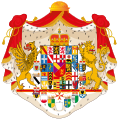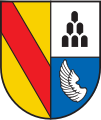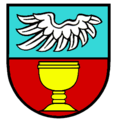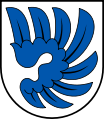Üsenberger

The Üsenbergers , who are also referred to as the Lords of Üsenberg , were an important noble family in the Breisgau and Markgräflerland during the 11th to 14th centuries; they founded several cities such as Kenzingen and Sulzburg .
history
The Lords of Rimsingen are considered ancestors or a branch of the Üsenberger . Because of the frequent occurrence of the name "Hesso", this is also conceivable for the Hesson family . Dietrich von Rimsingen, who lived in the last quarter of the 10th century, is considered the progenitor of the Üsenberg family and the Counts of Nimburg . The abbot Hesso von Üsenberg, who worked in the 12th century, was probably a scion of the two sexes .
The Üsenberger family belonged to the free nobility, they were vassals of the Bishop of Basel . You had been in office as the upper thigh of the Hochstift Basel since 1052 .
The first ancestral seat of the family was the Üsenburg north of Breisach on the Üsenberg , which was built in the 11th century and destroyed in 1291. Today there are no more traces of the castle and the mountain on which it stood. The area corresponds to the current field name Isenberg , on which an industrial area has been created since 1997 after the withdrawal of the French troops from the Vauban barracks .
After the destruction of this castle, the Üsenbergers exercised their rule from the Höhingen castle on the Schlossberg near Achkarren in the Kaiserstuhl . The castle was first mentioned in a document in 1259. Among the possessions of the noble family that belonged Castle Eichstetten , the Kirn castle , the castle Neuershausen , the Castle bars , the Castle Sulzburg and the castle Weisweil .
The town of Kenzingen was founded in 1249 by Rudolf II von Üsenberg next to the village of Kenzingen on the open field. A fountain in the town center has been in memory of the town's founder since 1824. This period can be seen as the height of the power of sex. It is also noticeable that they did not build a castle, but founded a fortified city, which, due to the larger population, had both a higher defense value and higher tax revenues.
The founding of the Wonnental women's monastery by Rudolf II von Üsenberg is also to be seen in connection with the founding of the city . It is first mentioned in a document in 1242. It is the home monastery and the family burial place . Originally a Dominican monastery , it was a Cistercian monastery from 1262 . After a checkered history, it was secularized in 1806 and fell to Baden . The buildings were then used by a beet and chicory factory, which is how industrialization in Kenzingen began. The Kirnburg can be seen as the third element of the center of power for the Lords of Üsenberg.
At the end of the 13th century, 1291/92, the rule of Üsenberg was divided into a lower and an upper rule , which must be considered independently of each other, after Hesso IV and Rudolf III. had ruled together. One of the prerequisites for the division were the urban elevations of Sulzburg around 1283 and Endingen am Kaiserstuhl around 1285/86.
After the division into the Upper Rule - the Endinger Line, starting with Burkhart II - and the Lower Rule - the Kenzinger Line, founded by Rudolf II - the decline of the family began relatively soon. The Kenzinger line no longer recovered from the consequences of the Battle of Göllheim in 1298, in the run-up to which the Pflixburg was pledged to the Üsenberger by King Adolf von Nassau . In 1352 the last male offspring of the Kenzingen line sold the city of Kenzingen to his brother-in-law Heinrich IV of Baden-Hachberg - a bad deal for Heinrich, since Friedrich had the city as a fiefdom from the Habsburgs and in 1365 they enforced their claims to Kenzingen in court. The line ends with the death of Friedrich von Üsenberg in 1354.
The Endinger line was defeated in the " Kaiserstuhl War " from 1320 to 1322 by the Lords of Falkenstein in the fight for the Bickensohl Bailiwick and the associated claims for damages. In addition, in 1336 Höhingen Castle, Eichstetten and Riegel Castle and Village were pledged by the Margrave of Hachberg, Heinrich IV. After the Freiburg War , Endingen fell to the Habsburgs . Hesso V. von Üsenberg was the last of the line; he died in 1379.
coat of arms
In blue, two silver wings pushed one inside the other and with the wings turned downwards. Later a golden clover stem was added. In this form, the Üsenberg coat of arms was also included in the coat of arms of the Grand Duchy of Baden , where it appears in the fifth field of the coat of arms shield and symbolizes the rule of Üsenberg as part of Baden.
The Üsenberg wing is also featured in a number of local coats of arms.
Coat of arms of the margraviate of Baden-Durlach
Herbolzheim coat of arms
Coat of arms of Kippenheimweiler
Coat of arms of Niedereggenen
Coat of arms of Dottingen
Family table
- Dietrich von Rimsingen
- Bechtold
- Rudolf
- Hesso von Eichstetten ⚭ Guta
- Hesso I. von Üsenberg († 1111)
- Hesso II.
- Hesso III. († 1160)
- Burkhart I († 1203)
- Rudolf I († 1231) ⚭ Helia von Lichtenberg
- Burkhart II. († 1248) ⚭ unknown from Urach
- Hesso IV. († 1306)
- Burkhart III. († 1336)
- Anna
- Johann († 1376)
- Burkhart
- Hesso V. († 1379) ⚭ Agnes von Geroldseck (called von Tübingen, called von Veldenz )
- Anna († 1424) ⚭ Konrad II. Von Tübingen-Lichteneck († 1449)
- Agatha († 1434)
- Gebhart
- Burkhart III. († 1336)
- Hesso IV. († 1306)
- Rudolf II. († 1259) ⚭ 1. Kunigunde von Katzenelnbogen († 1253), ⚭ 2. Elisabeth von Lichtenberg († 1270, see master list of the Lords of Lichtenberg )
- Rudolf III. (from 1st marriage, † 1296) ⚭ Helica von Lichtenberg
- Burkhart (from 1st marriage, † 1305)
- Hesso († 1331)
- Burkhart IV. († 1336) ⚭ 1. unknown, ⚭ 2. Luggart von Geroldseck
- Anna (from 1st marriage, † 1356) ⚭ Heinrich IV. Von Baden-Hachberg († 1369)
- Clementa (from 2nd marriage) ⚭ 1. Otto I. von Tierstein († 1352), ⚭ 2. Heinrich von Blumeneck († 1363)
- Hesso (from 2nd marriage, † 1379) ⚭ 1. Gisela Malterer († 1363), ⚭ 2. Agnes von Geroldseck
- Anna (from 1st marriage, † 1400) ⚭ Konrad I. von Tübingen-Lichteneck († 1410)
- Anna (from 2nd marriage, † 1437) ⚭ 1. Werner von Hornberg , ⚭ 2. Reinold VI. von Urslingen († 1442)
- Johann (from 2nd marriage, † 1376) ⚭ Anna von Kirkel
- Udelhild ⚭ Johann I. von Schnabelburg, Vogt von Schwarzenberg
- Burkhart IV. († 1336) ⚭ 1. unknown, ⚭ 2. Luggart von Geroldseck
- Hesso († 1331)
- Anna (from 1st marriage) ⚭ Heinrich II. Von Baden-Hachberg († 1297/1298)
- Rudolf IV. (From 2nd marriage, † 1304) ⚭ Adelheid
- Elisabeth ⚭ Heinrich IV. Von Rappoltstein and zu Hohenack
- Anna ⚭ Heinrich, Lord of Schwarzenberg
- Hugo († 1343) ⚭ Sophie von Horburg
- Clare († 1350) ⚭ Walter VI. von Geroldseck († 1349)
- Katharina ⚭ unknown from Landsberg
- Adelheid († 1353) ⚭ Luitold II. Von Krenkingen († 1360)
- Friedrich († 1354) ⚭ Susanna II. Von Geroldseck
- Burkhart II. († 1248) ⚭ unknown from Urach
- Rudolf I († 1231) ⚭ Helia von Lichtenberg
- Burkhart I († 1203)
- Hesso III. († 1160)
- Hesso II.
- Hesso I. von Üsenberg († 1111)
literature
- Johann Christian Sachs : Introduction to the history of the Marggravschaft and the Marggravial old princely house of Baden . First part. Lotter, Carlsruhe 1764, p. 607–640 ( limited preview in Google Book search).
- Heinrich Schreiber : Document book of the city of Freiburg im Breisgau , Volume 1, 1828 ( digitized version of the Freiburg University Library ).
- Heinrich Maurer : The barons of Üsenberg and their church fiefs , in: Journal for the history of the Upper Rhine , Volume 67, 1913, p. 370 ( digitized in the Internet Archive ).
- Ansel-Mareike Andrae-Rau: Observations on the castles and town politics of the Lords of Üsenberg in the 13th century , In: Das Markgräflerland , Volume 2/2003, pp. 130-140 ( digitized version of the Freiburg University Library ).
- Karl Hartfelder : Weisthum des üsenbergischen Dinghofes zu Bischoffingen 1279 , in: Zeitschrift für die Geschichte des Oberrheins, Volume 34, 1882, S. 234-239 ( digitized in the Internet Archive ).
- Fridrich Pfaff : Interest toboggan from Burkhart from Üsenberg to Achkarren at the Kaiserstuhl . In: Alemannia , Vol. 19 (1892), pp. 183-188 ( digitized in the Internet Archive ).
- Rainer Kiewat: The castles of the Üsenbergs: Kirnburg, Üsenberg Castle, Riegel Castle, Höhingen Castle . Kenzingen 2006.
- Lorenz Werkmann: The Counts of Nimburg in Breisgau . In: Freiburger Diözesan-Archiv Volume 10 (1876), pp. 71–83 with an addendum by Josef Bader , pp. 84–96 ( digitized version from the University of Freiburg ).
Web links
- Stefan Hess : Üsenberg, from. In: Historical Lexicon of Switzerland .
- Herren von Üsenberg at alemannische-seiten.de
- Üsenbergbrunnen Kenzingen at alemannische-seiten.de
- Endinger documents from the 14th century at endinger-geschichte.de
Individual references / comments
- ↑ Oberrimsingen - Altgemeinde ~ Teilort at leo-bw.de , accessed on May 19, 2013.
- ^ Werkmann / Bader, p. 82.
- ^ Arne Bleckmann, Stefan Wald: Protocol of the history seminar of the University of Freiburg. portal.uni-freiburg.de , June 8, 2005, archived from the original on January 29, 2010 ; accessed on November 16, 2016 .
- ↑ Michael Raith : Gemeindekunde Riehen , Riehen 1980, p. 42.
- ^ Franz Xaver Kraus : Die Kunstdenkmäler des Großherzogthums Baden , Volume 6, Tübingen 1904, pp. 315-316 ( digitized version of the Heidelberg University Library ).
- ↑ This castle is evidenced by the permission granted by Bishop Berthold of Strasbourg in 1349 for Friedrich von Üsenberg to pass on the castle and village of Weisweil to his wife as marriage equipment.
- ↑ 1283 mentioned in a document as a fortified city
- ^ The battle of Göllheim am Hasenbühl on July 2, 1298. breisgau-burgen.de, accessed on July 13, 2020 .
- ^ Franz Zell: History and description of the Baden coat of arms from its creation to its current form , Karlsruhe 1858 ( digitized at Google Books ).
- ↑ State coat of arms 1807 in the Stadtwiki Karlsruhe .
- ↑ Hesso von Eichstetten. our-royal-titled-noble-and-commoner-ancestors.com, accessed on May 29, 2018 .
- ↑ Hesso III. from Üsenberg. genealogy.net , accessed May 29, 2018 .
- ^ Rudolf I von Usenberg. our-royal-titled-noble-and-commoner-ancestors.com, accessed July 14, 2020 .
- ^ Burkhart III von Üsenberg. geneanet.org , accessed May 29, 2018 .
- ^ Walther Möller: Family tables of West German aristocratic families in the Middle Ages . Vol. 3 = Manfred Dreiss (Hrsg.): Library of Classical Works of Genealogy Vol. 2.3. Darmstadt 1936. ND: Neustadt an der Aisch 1996, plate 95.
- ^ Entry on Höhingen in the scientific database " EBIDAT " of the European Castle Institute.
- ^ Kenzingen - The short way through the long history , p. 123, published by the Heimat- und Verkehrsverein eV Kenzingen, 1989.













